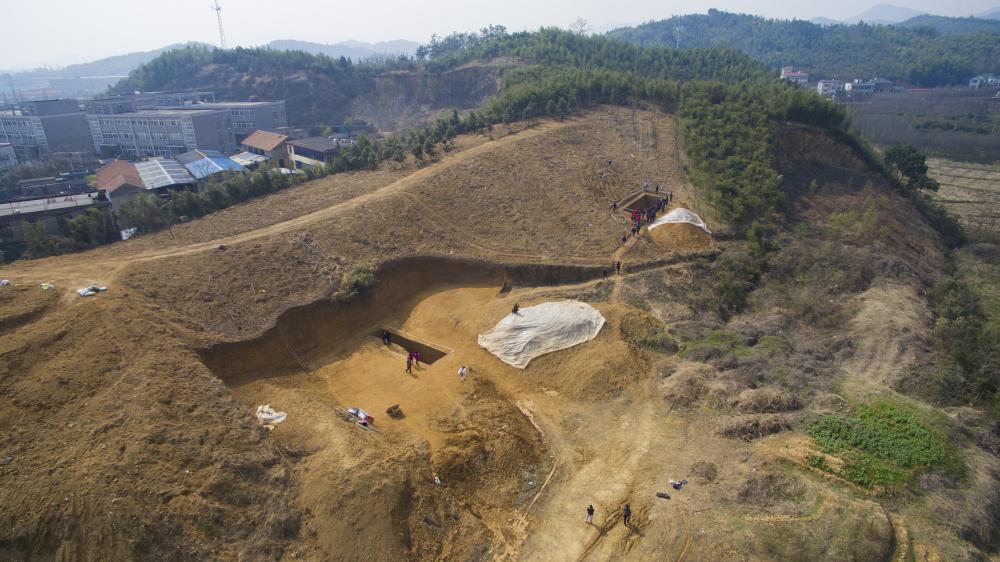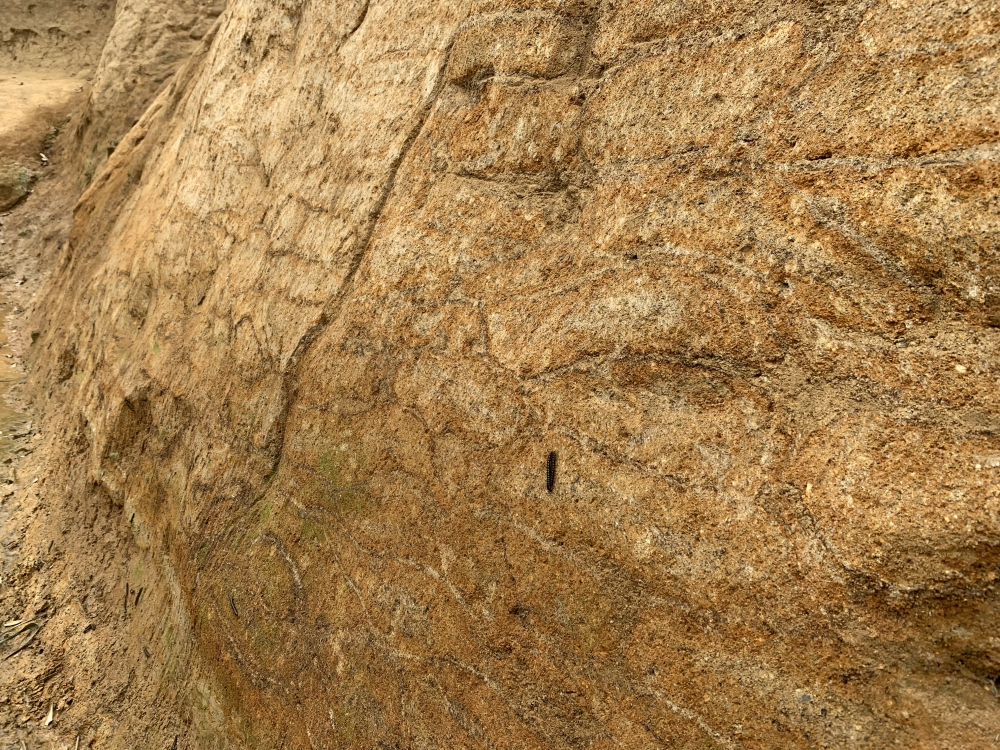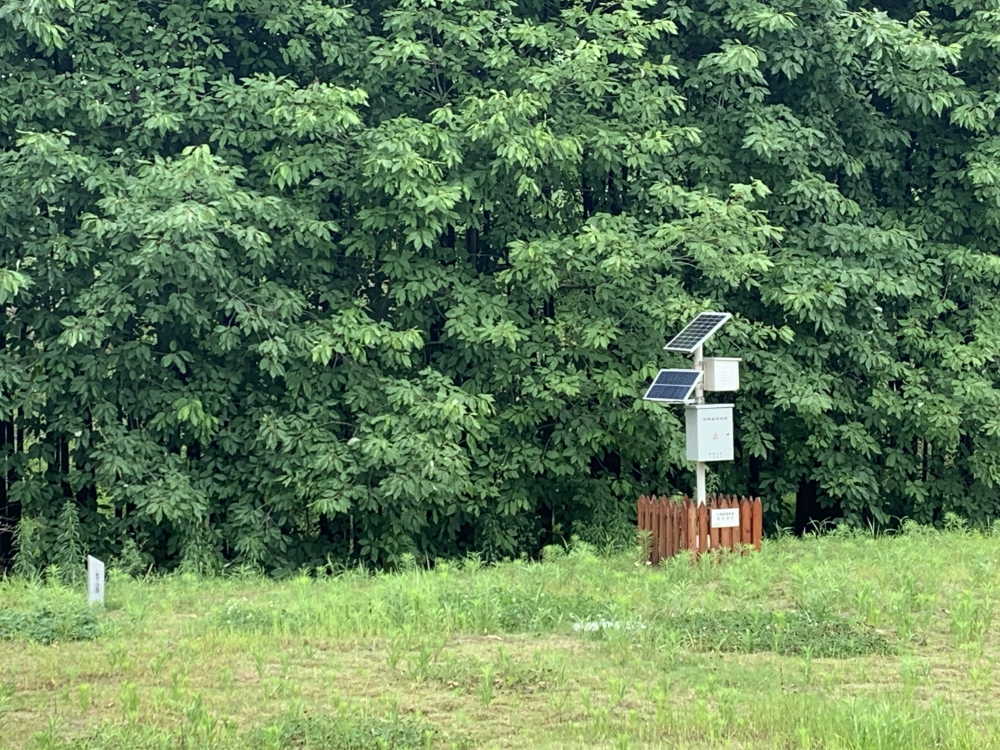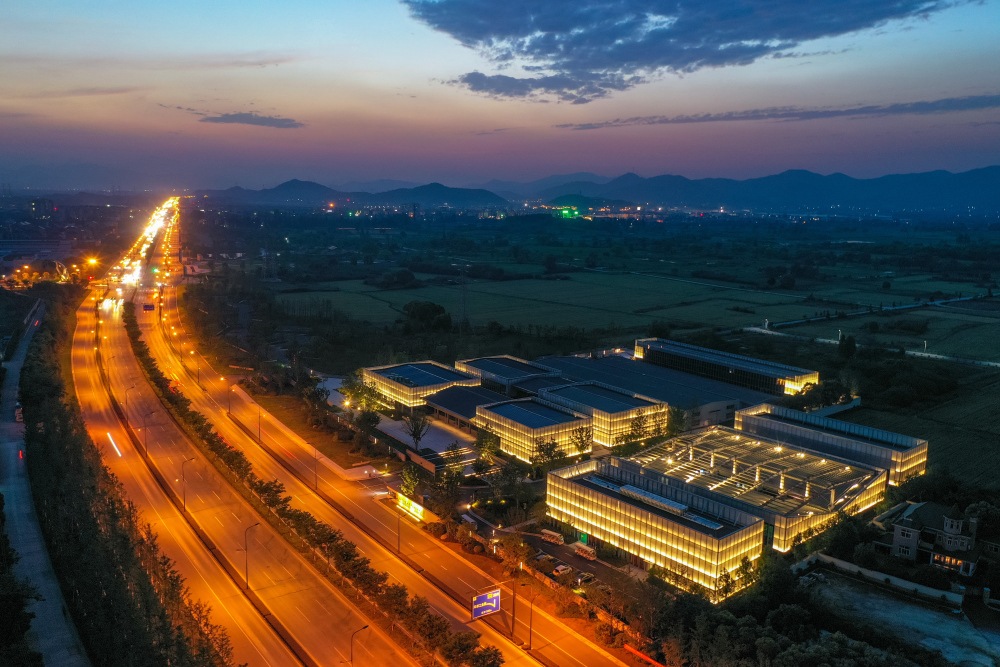良渚古城遗址申遗成功,就意味着遗址的保护管理进入到了承担国际义务、履行公认的国际准则这一国际视野中了。
“作为世界文化遗产,遗产地需要定期向联合国教科文组织提交遗产地保护状况评估报告,国家文物局也要求遗产地每年提交一次年度报告。”中国文化遗产研究院世界文化遗产监测中心主任赵云说。监测是遗产地科学保护遗产的有效手段之一,也是有效反映遗产地保护管理状况的重要内容。
监测之外,避免人为伤害
良渚古城遗址能够申遗成功,一个重要的基础是它一直得到有效的保护。
从1987年开始,余杭就设立了专门的保护机构,发展到今天,是由杭州良渚遗址管理区管理委员会(以下简称管委会),对良渚古城遗址进行全面的保护管理。
杭州良渚遗址管理区管委会文物与遗产管理局副局长孙海波说,从2013年开始,管委会就开始做遗址监测相关的考察工作,并且确定了两支专业的团队,分别完成专业监测方案的编制、监测预警系统的开发。
这项工程,相当于给5000岁的良渚古城遗址聘请了专业医生,并定制了一个个性化的“体检套餐”。
杭州良渚遗址遗产监测管理中心,专门负责对良渚古城遗址实施具体的日常监测管理工作。该中心主任郭青岭介绍说:“良渚遗址分布范围广、遗存要素多,周边环境复杂、建设压力大,必须规范有序地对遗址执行日常监测保护任务,并采用高科技手段,确保遗产本体和环境得到有效的保护管理。”
“对旅游和游客的监测,是国际遗产公约关注的一个方面,也是我们需高度重视的新情况,尽量避免人为因素对遗址造成有害影响。”郭青岭告诉笔者,未来良渚遗址监测目标是科技化、研究化、国际化、社会化、系统化,确保良渚古城遗址这一世界文化遗产得到永续保存。
“体检”套餐,助力保护管理
笔者近日探访了良渚古城遗址谷口高坝区的老虎岭遗址,观察这个良渚遗址中典型的监测点,是如何接受科技设备实施日常“体检”的。
2007年良渚古城被正式发现后,考古专家在古城的西北面,发现了11条水坝。老虎岭就是其中一条高坝。

笔者在现场看到的老虎岭水坝,是一个黄土的剖面,人可以走到水坝跟前去细看:巨大的水坝,由成千上万个小块面组成;每个块面之间,有非常明显的白色细线。

“这是烂掉的草。”浙江省文物考古研究所研究员王宁远告诉笔者,坝体的底部是淤泥,上覆黄土。“在部分坝体的关键位置,良渚人用了‘草裹泥’技术纵横堆砌。这种效果,与现代营建堤坝时用草袋装土类似,可使坝体增加抗拉强度,不易崩塌。”
“‘草裹泥’本身体量很小,又软,可塑性好,与外面草茎贴合紧密,所以堆垒后,完全不会漏水。”王宁远说。
5000年过去了,“草裹泥”建筑的老虎岭大坝,正在经受时间的考验。
目前,整个老虎岭遗址,设有8个高科技监测设备,对这一区块的良渚古城遗址遗产区、缓冲区共计114平方公里范围,进行天空地一体化监测。
8项黑科技,守护良渚
● 可见光热红外监测
针对老虎岭土体渗水、管涌、冲沟等病害,老虎岭大坝上的摄像头配了可见光热红外设备,每天定时定点进行数据采集工作,获取不同天气、季节等环境下的红外影像视图,配合时间轴、对应数据,呈现该监测点的温度、湿度变化状况。
监测管理中心在雨后都会增加一次数据采集,观察和记录雨后渗水的情况,加盖保护棚后,这块区域的渗水情况控制良好。
● 土壤墒情监测
土体太干燥,会产生土体的开裂和风化;太湿润,则会造成苔藓滋生等微生物病害问题。所以,老虎岭坝体的西边,有三个土壤墒情监测设备。墒情指土壤温湿度情况。
每个设备差不多有成年男士拳头大小,分别位于大坝的上、中、下部位。设备看起来是3个盖帽,里面有探针,深入大坝土体20公分左右,实时监测土壤表面和土壤内部的温、湿度。
● 微环境监测
老虎岭作为一个土遗址的展示点,常年暴露在外,它比回填的遗址,受到了更多的挑战。比如,坝体的很多地方,能够清晰地观察到苔藓的生长痕迹。苔藓的生长,会破坏草裹泥结构,从而进一步影响坝体的结构。
为保护坝体剖面,老虎岭坝体展示区的上方建有一个透明的顶棚。
● 小型气象站监测
在老虎岭遗址区域东边的自然山体上,建设了一个小型气象站,实时监测老虎岭遗址整体环境的空气温湿度、风速、风向、降雨、噪声等数据。
● 地下水位水质监测
在老虎岭遗址区域北部有一个地下水位水质监测设备,对整个老虎岭的地下水位水质变化情况进行实时监测。

● 可见光摄像头拍摄
针对距古城遗址点较远、病害因素复杂等特点,对老虎岭土体还同时采用了布设摄像头的方式,进行实时摄像监测观察。
● 无人机拍摄、高清遥感影像监测
利用遥感影像,以及使用无人机和相机进行定点拍照的监测方法,重点监测遗址四大片区内重要的空间关系,了解良渚古城遗址的重要形态是否发生变化,评估可能出现的变化对古城遗址的影响。
从保文物到说文物
不断增强的文化自觉
古往今来在大地上生生不息的人民,是一切文化遗产的创造者、使用者和守护者,是文化遗产的真正主人。保护文化遗产归根到底离不开人民群众的力量。
初夏,余杭良渚街道港南村里绿树成荫,清水环绕。“这几年,经过良渚古城遗址保护和美丽乡村建设,生态环境大大提升。以后村里可以与周边历史文化遗迹相结合,设计文化一日游……”村民代表大会上,村委会主任康宏果向村民讲述良渚古城遗址保护带来的“红利”。
这些年来,遗址内外农户外迁,水稻、油菜等传统作物恢复,轻型农业、观光农业、大地景观等新型产业注入,呈现出一派野趣充盈的自然生态景象。当地居民生活环境和品质因此大大提升。
群众护地,也同时护宝。“良渚遗址区域极大,早些年刚被政府部门‘管起来’时,保护机制还没能跟上,盗墓分子的觊觎让人提心吊胆。多亏当地村民及时提供大量有价值的信息!”忆起和群众并肩作战的过往,曾任杭州良渚遗址管理所所长的费国平流露钦佩之情。
康宏果得过“良渚遗址保护特别贡献奖”;其父康烈华还是1985年成立的群众组织“良渚文化研究会”的早期会员。康家父子守护良渚文物的故事远近闻名:2006年,康家经审批在自家院里建房时,竟然挖出4个玉璧,父子俩马上向相关部门汇报,经过抢救性发掘,良渚文化中晚期19座权贵墓葬和200多件珍贵文物露出真容。
“守住良渚遗址,就守住了国家历史。这是‘文保员’的责任!”承担工期延误的经济损失,康烈华从来不觉后悔,“我一辈子和良渚文化打交道,只要我的生命存在一天,就要为保护良渚文化努力一天!”
“文保员”是这群朴实农民引以为傲的头衔。除了康家父子,还有张金千顶着压力,及时汇报瑶山遗址盗掘情况;姚来根不管农活多忙,每天总要抽出时间去分管的砂矿走一走……
随着良渚遗址保护机制日益完备,当地群众逐渐从“保文物”转向“说文物”,把广泛传播良渚价值作为自己的新使命。
钱琴英生在良渚、长在良渚,家门口就是遗址区,曾被评为“浙江省杰出青年志愿者”。1994年,良渚博物院前身良渚博物馆开馆,18岁的她就是义务讲解员。从义务讲解员到正式讲解员已经过去20多个年头。
2010年,良渚博物院志愿者服务社成立,越来越多的当地群众加入队伍。他们负责维护参观秩序、提供耐心导览。“从1973年到良渚从教开始,这里就是我的家。我想把家乡的故事说给大家听。”70岁的陈中柱是服务社的第一任社长。即便年迈,他仍愿意多进社区,为居民进行良渚文化宣传讲座。截至2019年5月底,服务社累计注册志愿者506人,在岗服务的有156人。今年以来,志愿者们共为5700名游客提供295场讲解,人均服务时数超过49小时。
伴随群众文化自觉不断增强,良渚遗址保护真正成为了这片土地上每个人的事。良渚,这份独一无二的瑰宝中蕴藏的民族精神和独特的审美情趣、独特的传统气质,得以不断传承。
World Heritage Status: New Departure Point for Safeguarding
The inscription of the Archaeological Ruins of Liangzhu City as a world heritage site means that international norms and standards now apply to the conservancy and management of the inscribed property and that safeguarding projects and measures are now under the scrutiny of international community. The administration in charge of managing the world cultural heritage site in Liangzhu must submit an evaluation report to the UNESCO at regular intervals and make an annual report to the China National Administration of Cultural Heritage.
In fact, the successful inscription of the Archaeological Ruins of Liangzhu City as a world heritage site can partly be attributed to the protective measures effective since 1987 when a committee was set up to oversee the administration of the archaeological sites of Liangzhu. The committee has been functioning well since then. In 2013, the committee started doing field studies and making preparations for the overall daily monitoring of the archaeological site zone. Two special taskforces were set up to formulate a monitoring plan and develop a monitoring and alert system respectively. This project works like a full-time doctor for the 5,000-year-old Liangzhu Site. A monitoring and management center is in charge of the daily work for all the archaeological sites. The monitoring and alert system is a must as the Liangzhu Culture sites spread in a vast region where both environment and site terrains are complex. Moreover, urban and industrial developmental projects may pose threats to the safeguarding of these sites. On the other hand, the authorities also need to monitor tourism activities and watch out for threats that might damage the sites on the part of tourists.
Take the Laohuling Site for example. The Laohuling Dam is one of the 11 dams in the peripheral water conservancy system discovered in recent years.

Visible Infrared Devices
The visible infrared devices work together with cameras on the dam to collect data at appointed times and at appointed spots. The data then goes into a databank so that changes in temperature and moisture can be monitored closely. Moreover, additional data collection is carried out after a rainfall so as to watch out for possible water seepage. Water seepage is now under control thanks to a protective shelter structure installed above the dam. The data is carefully analyzed to spot early signs that hazards such as piping erosions or gullies may materialize.
Soil Moisture Content
On the western side of the Laohuling Dam are three devices that monitor soil moisture content of the dam. The device is like a fist of an adult man in size. The three devices are installed respectively at the top, the center and the bottom of the dam. The monitor has a probe 20 centimeters into the soil. The devices get real-time data on soil temperature and moisture from the surface and inside the dam. The monitoring is necessary because dry conditions may cause the dam to crack and corrode and because wet conditions may lead to the harmful growth of moss.
Microenvironment
A profile section of the Laohuling Dam, now an exhibition spot of the earthen archaeological site, is exposed, and thus subjected to more challenges in comparison with the sites which were backfilled after archaeological excavation. Nowadays, the growth of moss can be seen in many sections of the dam. Moss can be a serious threat to the structure of the grass-soil packs, basic building blocks of the dam. In order to protect the profile, a transparent roof structure is installed above the exhibition section.
Weather Station
A small weather station, now functioning on a nearby natural hill to the east of the Laohuling Dam site, monitors the weather conditions of the site under protection. Information collected there includes data on temperature, moisture, wind speed and direction, rainfall, and noise.
Underground Water Level
and Quality
A device situated in the north of the Laohuling Site area monitors underground water level and quality of the whole area. The device watches out for any change in underground level and quality
Cameras
A camera system is now in place to monitor the whole Laohuling Dam site since the site is situated relatively remote from the monitoring center and natural hazards can happen in many complicated ways.
In addition, drones regularly photo all the sites. Four important areas are at the top of the monitored targets. The aerial views are used to detect any possible changes in the spatial relations of the four areas. If changes happen, changes will be evaluated to see if they affect the outstanding universal value of the heritage site.
Local People Play a Central Role in Site Safeguarding
and Promotion
Local people have been playing a big role in the safeguarding of the Archaeological Ruins of Liangzhu City since archaeological exploration started on a large scale decades ago. Over the last few years, the efforts to get Liangzhu inscribed onto the World Heritage List have transformed the rural Liangzhu. Living conditions for rural residents in Liangzhu have greatly improved. Many residents living inside and outside the property as inscribed on the World Heritage List have been relocated to make room for an overall safeguarding and restoration project. Thanks to the project, traditional crops such as rice and canola have been reintroduced. Landscape, agriculture, tourism have been developed. Local people like the improved environment and living conditions.
In early years when the government first placed a large area as Liangzhu Culture Site under protection, the protection mechanism did not yet function well. Local residents banded together to watch out for any possible tomb robbery. For years, community-based watching and alerting system assisted the local government in preventing and stopping some tomb robberies.
Mr. Kang Hongguo, a manager of Gangnan Village within the archaeological site, is a winner of special contribution prize for the safeguarding of Liangzhu Site. His father Kang Liehua is a member of Institute for Liangzhu Culture Research, a local non-government institution set up in 1985 in Liangzhu. Years ago the father and son stumbled into four jade Bi on the building site of their house and immediately reported the discovery to the authorities in charge of archaeological work and preservation of cultural relics. A rescue exploration project conducted on the building site and beyond led to the discovery of 19 high-graded tombs and over 200 precious grave goods. There are many stories about local people who act as self-appointed guardians of cultural relics of the Liangzhu Culture and take it upon themselves to protect Liangzhu archaeological wealth.
Of numerous volunteers in Liangzhu, Qian Qinying stands out. When the Liangzhu Museum first opened its door to the public in 1998, the 18-year-old Qian volunteered to be a narrator for visitors. Over the past 20 some years, Qian has grown up through self-education and hands-on experience to be an expert on the ancient glory of Liangzhu. She is now an employee of the museum. She thinks it an honor to share Liangzhu with visitors from all over the world.
In 2010, Liangzhu Museum set up a volunteer service. Volunteers maintain order at the museum, provide information, and narrate for visitors. 70-year-old Chen Zhongzhu is the first director of the volunteer service. He came to teach at a local middle school in Liangzhu in 1973. He considers Liangzhu as his home and he is willing to share his love of Liangzhu with visitors through the volunteer work. Nowadays, he gives lectures on Liangzhu at local residential communities.
According to the data at the end of May 2019, the service has 506 registered members and 156 of them do volunteer work at regular intervals. In 2019 alone, volunteers have provided 295 narrations for 5,700 visitors. Their volunteer work averages 49 hours per person.
